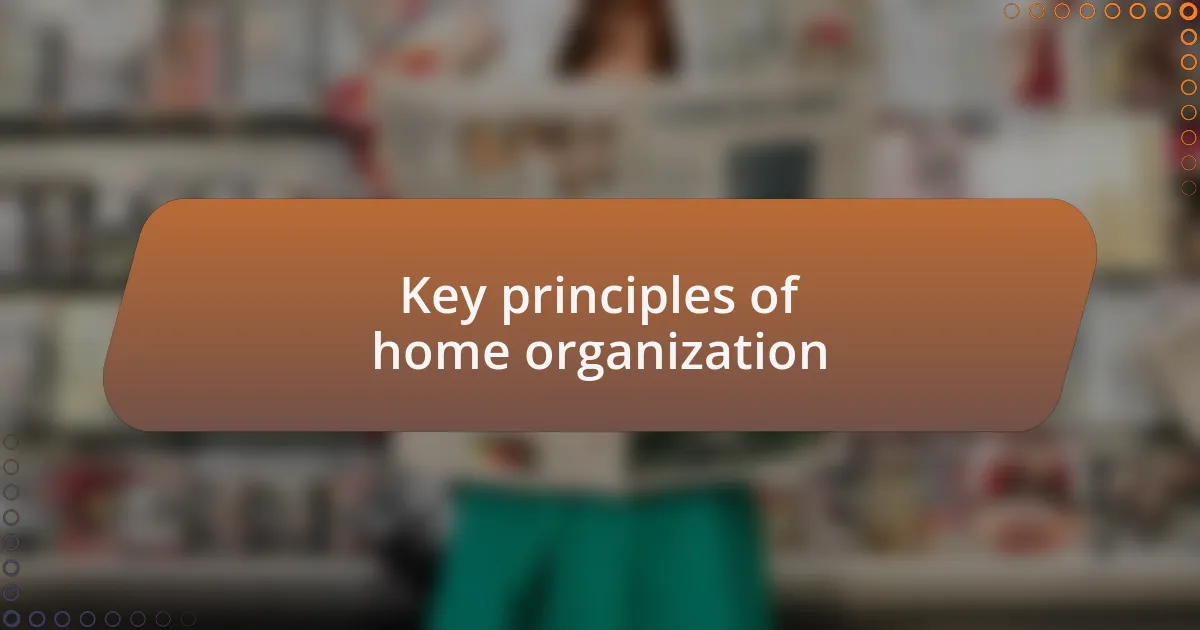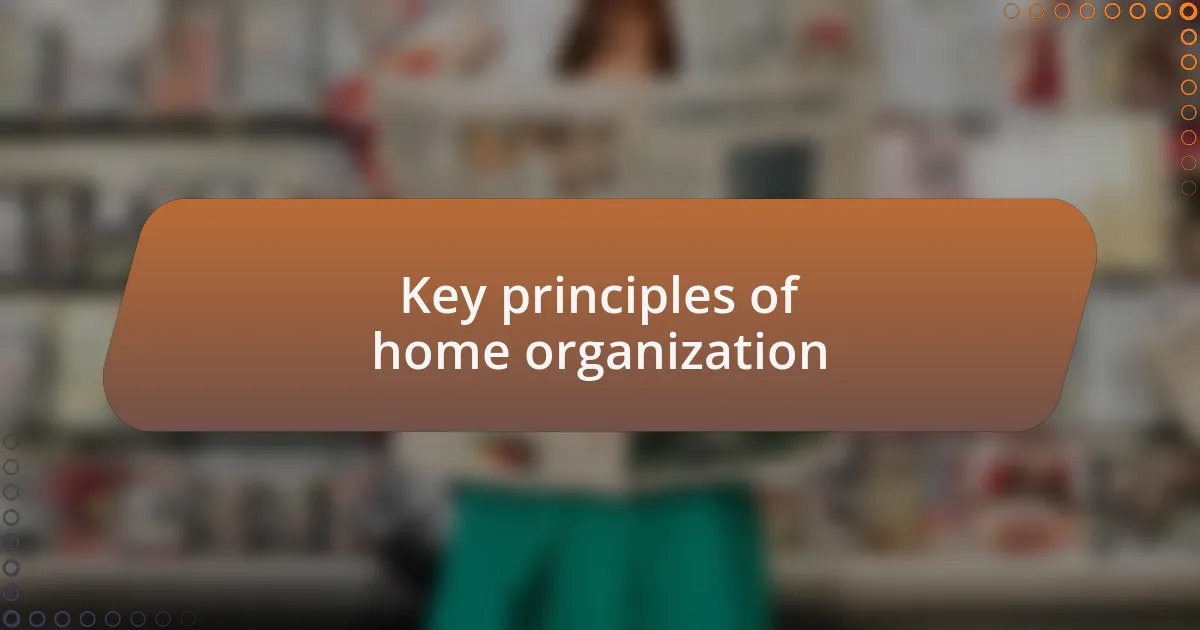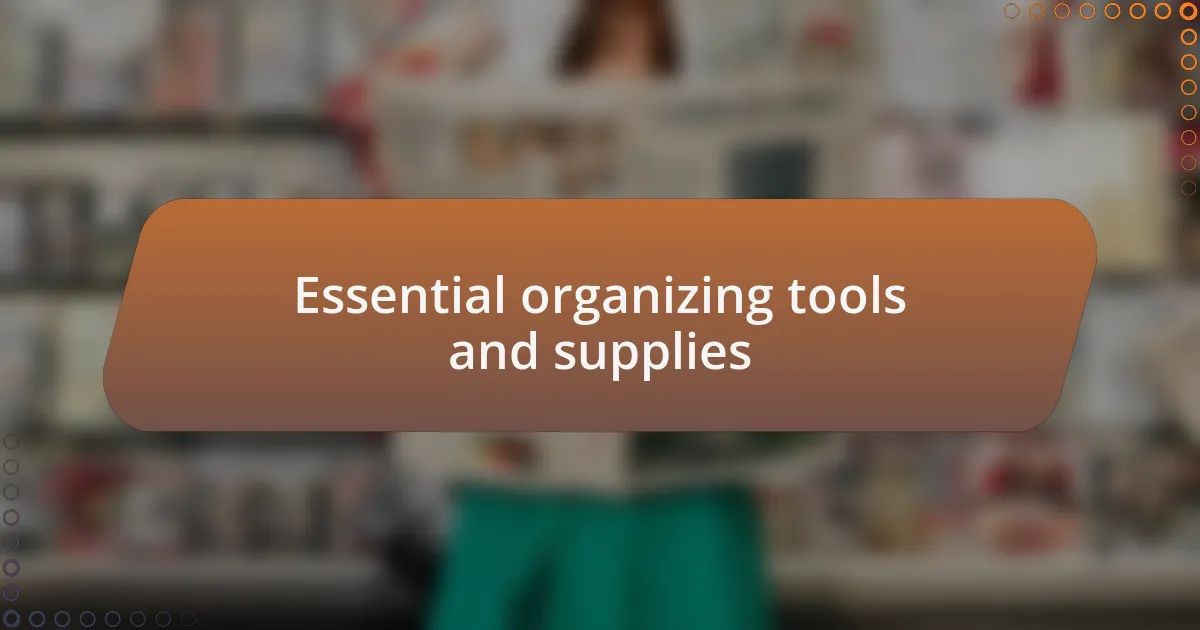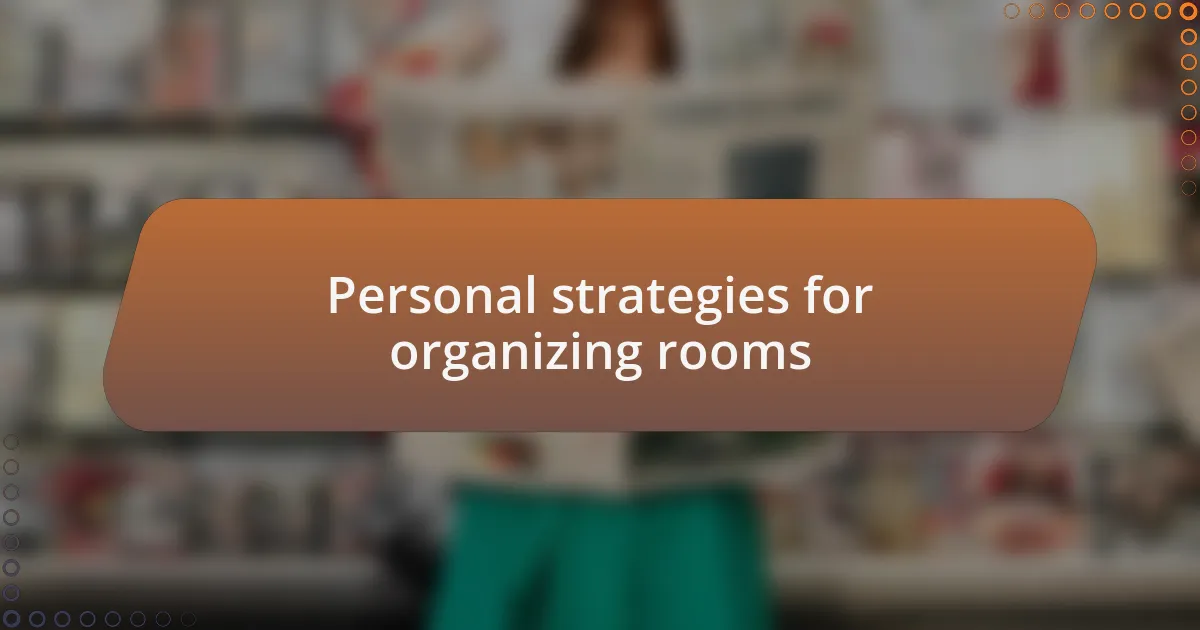Key takeaways:
- Home organization reduces stress and fosters a calm mindset, promoting productivity.
- Key principles include having a designated place for everything, regular decluttering, and ensuring functionality to streamline daily routines.
- Techniques like starting small, the “one in, one out” rule, and tracking progress with photos can effectively clear clutter.
- Essential tools like transparent bins, labels, and drawer dividers enhance the organizing process by making items easily accessible.

Understanding home organization benefits
I remember the moment I decided to organize my home. It wasn’t just about creating a tidy space; it was about lifting a weight off my shoulders. An organized home can significantly reduce stress. When everything has its place, you can navigate your daily routine with ease, leaving more room for what really matters.
Have you ever walked into a cluttered room and felt an immediate wave of anxiety? I have, and it’s overwhelming. By organizing my space, I found that I could think more clearly and focus on tasks without distractions. It’s fascinating how our environment affects our emotions; an organized home nurtures a calm mindset and fosters productivity.
One of the most rewarding benefits I discovered was the sense of accomplishment that comes with each completed organizing project. I felt a burst of happiness as I cleared out forgotten items and made space for things I truly cherish. It’s a reminder that home organization isn’t just physical; it’s freeing emotionally, too, allowing us to reclaim our space and, by extension, our peace of mind.

Key principles of home organization

Key principles of home organization
One fundamental principle of home organization is to embrace the idea of “a place for everything.” I still remember when I decided to dedicate a specific drawer for all my chargers and cables. It transformed my daily routine; instead of rummaging through a tangled mess, I could easily find what I needed, making my mornings smoother and less stressful.
Another key principle is the practice of decluttering regularly. In my experience, holding onto items “just in case” only leads to overwhelm. After a seasonal clean-up, I feel lighter both physically and mentally; it’s liberating to let go of things that no longer serve a purpose in my life. When did you last ask yourself if an item truly adds value?
Lastly, functionality should be at the heart of your organizing efforts. I learned this when reorganizing my kitchen; I placed frequently used pots and utensils within easy reach. This simple adjustment not only streamlined my cooking process but also turned meal preparation into a more enjoyable experience. It’s intriguing how small changes can significantly impact our daily habits.

Steps to clear clutter effectively
When tackling clutter, I’ve found that starting small makes a significant difference. I often pick a single area, like a tabletop or a drawer, and commit to clearing it out in one sitting. By focusing on a manageable space, I avoid feeling overwhelmed and can celebrate the small victory of having a tidy surface, which motivates me to continue.
One technique I employ is the “one in, one out” rule. Whenever I buy a new item, I make it a point to let go of something similar. For instance, when I brought home a new pair of shoes, I parted ways with an older pair that I hadn’t worn in ages. This practice not only keeps my space from accumulating more clutter but prompts me to think critically about my purchases. Have you ever realized you have multiples of something just because you didn’t actively decide to let go of the old ones?
Tracking your progress can also keep you motivated during the decluttering process. I like to take before-and-after photos of each area I organize. Looking back at those images gives me a sense of accomplishment that I can physically see, while also reminding me why I started the journey in the first place. Don’t you find it exciting to witness your own transformation?

Essential organizing tools and supplies
When organizing my home, I’ve come to rely on a few essential tools that truly make the process easier. Transparent bins are my go-to for storing items. Being able to see inside them helps me remember what I have and, surprisingly, makes me less anxious about searching for things. Have you ever noticed how easy it is to forget what you own if it’s tucked away out of sight?
Labels are another invaluable tool in my organizing toolkit. I use a label maker to clearly identify what’s inside each container and drawer, which saves me time and frustration. It’s amazing how a little word on a sticker can reduce the chaos in daily life. Every time I retrieve an item, I feel a rush of satisfaction knowing exactly where to find it.
I also swear by drawer dividers. They help keep my miscellaneous items from turning into a jumbled mess. I vividly recall how I used to struggle to find a pen or tape, often digging through a cluttered drawer. Now, with dividers in place, those essentials are always within reach. Doesn’t it feel rewarding to have a designated spot for everything?

Personal strategies for organizing rooms
Creating a functional space starts with decluttering. I usually set a timer for 15 minutes and tackle one area at a time. This approach prevents overwhelm and helps me stay focused. Isn’t it interesting how a small time commitment can lead to significant changes?
Once I’ve cleared the clutter, I like to assess the layout of the room. I often rearrange furniture to maximize both functionality and flow. There’s something oddly satisfying about creating a fresh perspective in a familiar space. Have you ever moved a couch just a few inches and suddenly felt like the whole room opened up?
Finally, I love incorporating multi-functional furniture, especially in smaller rooms. A bed with storage underneath or a coffee table that doubles as a desk can work wonders. It’s incredible how these small changes can create a more organized and spacious feel. What strategies have you found effective in optimizing your own living spaces?

My favorite organizing success stories
One of my favorite organizing success stories involves my kitchen. I decided to tackle the chaos of my pantry, which had become a black hole for expired items. I had a lightbulb moment while emptying it—seeing everything spread out made me realize how much I had been wasting. I sorted everything into clear bins and labeled them. Now, not only can I find everything easily, but it feels like I’ve gained a whole new room. Isn’t it amazing how organization transforms our experiences with everyday tasks?
Another memorable experience was when I completely reorganized my home office. It was a space of constant distraction filled with clutter. I remember feeling a sense of liberation when I cleared off my desk and sorted through all the papers. I added a few personal touches like plants and photos, creating an inviting atmosphere that now fuels my productivity. Have you ever had that moment when a space suddenly feels like your own creative haven?
One success that stands out is my overhaul of the kids’ playroom. Initially, it was a battleground of toys strewn everywhere, leading to countless “clean up” battles. After involving my children in the process, we categorized toys into bins and established a fun system for choosing what to keep. Watching them take pride in their organized space and actively participate in maintaining it felt incredibly rewarding. It’s fascinating how children can grasp the importance of organization when they’re part of the solution, don’t you think?